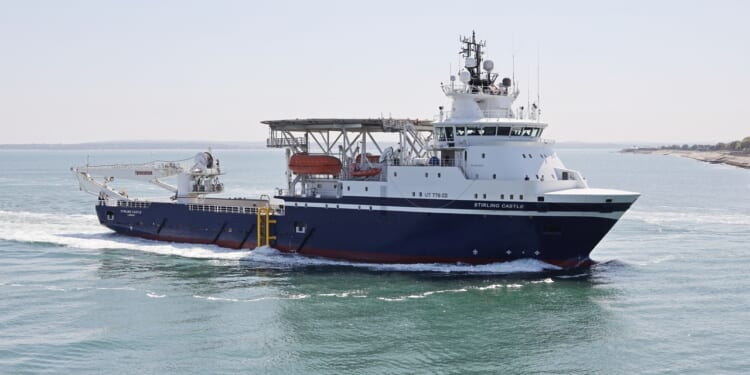The new HMS Stirling Castle is not a purpose-built minesweeper, but a civilian vessel bought by the Royal Navy and converted into a mothership for naval minehunting drones.
The Royal Navy received its newest specialized warship this month—a vessel that will play a key role in the service’s adoption of remotely-controlled and autonomous uncrewed systems.
Unlike the majority of the senior service’s fleet, which is painted in “Admiralty Grey” to help reduce the visibility on the open seas, HMS Stirling Castle (M01) features a “distinctive blue-and-white” paint scheme that denotes it as a minehunting ship. The choice of color allows it to be easily spotted by other ships, helicopters, and aircraft. It will also operate in littoral and near-shore waters, reducing the need for it to blend in with the horizon.
The Royal Navy shared images on social media of the vessel arriving at Portsmouth earlier this week.
What’s the Difference Between a “Minehunter” and a “Minesweeper”?
HMS Stirling Castle is also part of the continued shift away from minesweepers to minehunters. The former attempt to clear large areas of enemy naval mines without prior knowledge of their exact locations. In contrast, the latter employ sonar and other sensors to actively detect, locate, and neutralize specific mines.
The warship wasn’t purpose-built for the job, however. Instead, she previously operated as the commercial vessel MV Island Crown, serving as an offshore supply vessel, before being acquired by the Royal Fleet Auxiliary (RFA). Due to personnel shortages with the RFA, the ship was transferred to and commissioned by the Royal Navy this past summer to serve as a minehunting ship with the Portsmouth-based Mine Countermeasure Squadron 2.
The former commercial vessel—one of two recently obtained by the Royal Navy to serve as a minehunter—underwent an extensive conversion and refit that included the installation of the tools required for its new role.
“This is quite a landmark. Behind us lie six months of intense work to get this ship out of lay-up, to train and to get to sea. Ahead of us lie many more months of building our knowledge, developing tactics and techniques and delivering 21st-Century mine hunting from our deck,” explained Commander Phil Harper, commanding officer of HMS Stirling. “My team can take great pleasure in their success so far—they have wildly exceeded expectations.”
The vessel completed a series of sea trials over the summer, which tested its propulsion, power generation, and heavy lift crane, as well as its medical and damage-control systems. It will conduct further crew training before beginning its first full deployment.
The Stirling Castle Is Ready for the Hunt
The newly commissioned HMS Stirling Castle will serve as a floating command and control platform for the Royal Navy’s Mine Threat Exploitation Group, supporting remotely operated and autonomous uncrewed surface vehicles (USVs) and uncrewed underwater vehicles (UUVs). The MTEG is tasked with finding and neutralizing mines and other unexploded ordnance. Displacing nearly 6,000 tonnes (6,613 tons) and 96.8 m (317 ft 7 in) in length, HMS Stirling Castle is far larger than the Royal Navy’s Hunt-class mine countermeasure ships, which displace just 740 tonnes (750 tons) and are 60 m (196 ft 10 in) long.
However, the larger ship could further enhance the group’s capabilities.
Instead of relying on hull-mounted sonar, the minehunter will deploy sea-based drones to carry out mine detection.
New Vessels Are Being Designed for Autonomous Minehunting
The Royal Navy has taken a lead in the development of autonomous minehunting USVs and UUVs. Earlier this year, it began tests of a 12-meter-long uncrewed surface vessel (USV) that can detect mines without putting sailors in harm’s way.
The fully autonomous minehunter can be launched from a mother ship or deployed in a harbor “to scour the seabed for mines.” It employs the Thales Towed Synthetic Aperture Multiviews systems, described as “one of the most sophisticated towed sonars in the world.” Artificial intelligence (AI) is further used to aid in target recognition, as it enables the platform to process massive amounts of data more quickly to classify and neutralize the mines.
The Sixth HMS Stirling Castle
The mine countermeasure support vessel M01 is the sixth Royal Navy or Royal Fleet Auxiliary ship named for Stirling Castle, one of the largest and most historically significant castles in Scotland. The first was a 70-gun third-rate ship of the line, built in the 17th century and lost in the great storm of 1703.
Five subsequent third-rate ships of the line were built and served with the Royal Navy in the 18th and early 19th century, with the last being a 74-gun ship of the line that served as a prison ship.
As noted, the Royal Navy has acquired two commercial vessels that have been converted to serve as specialized military vessels.
The United States Coast Guard had also acquired a commercial vessel, a former oilfield tug and ice-breaking supply ship, to fill the gap in the shortage of Arctic icebreakers.
The US Navy is taking another direction with its minehunters, opting to utilize its littoral combat ships (LCS), which were initially developed to serve as modular, multipurpose combatants, as dedicated mine countermeasure ships, replacing the aging Avenger-class MCVs that are now nearing the end of their service life.
About the Author: Peter Suciu
Peter Suciu has contributed over 3,200 published pieces to more than four dozen magazines and websites over a 30-year career in journalism. He regularly writes about military hardware, firearms history, cybersecurity, politics, and international affairs. Peter is also a contributing writer for Forbes and Clearance Jobs. He is based in Michigan. You can follow him on Twitter: @PeterSuciu. You can email the author: [email protected].
Image: Shutterstock / Kevin Shipp.


















